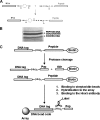Substrate cleavage analysis of furin and related proprotein convertases. A comparative study
- PMID: 18505722
- PMCID: PMC2475709
- DOI: 10.1074/jbc.M803762200
Substrate cleavage analysis of furin and related proprotein convertases. A comparative study
Abstract
We present the data and the technology, a combination of which allows us to determine the identity of proprotein convertases (PCs) related to the processing of specific protein targets including viral and bacterial pathogens. Our results, which support and extend the data of other laboratories, are required for the design of effective inhibitors of PCs because, in general, an inhibitor design starts with a specific substrate. Seven proteinases of the human PC family cleave the multibasic motifs R-X-(R/K/X)-R downward arrow and, as a result, transform proproteins, including those from pathogens, into biologically active proteins and peptides. The precise cleavage preferences of PCs have not been known in sufficient detail; hence we were unable to determine the relative importance of the individual PCs in infectious diseases, thus making the design of specific inhibitors exceedingly difficult. To determine the cleavage preferences of PCs in more detail, we evaluated the relative efficiency of furin, PC2, PC4, PC5/6, PC7, and PACE4 in cleaving over 100 decapeptide sequences representing the R-X-(R/K/X)-R downward arrow motifs of human, bacterial, and viral proteins. Our computer analysis of the data and the follow-on cleavage analysis of the selected full-length proteins corroborated our initial results thus allowing us to determine the cleavage preferences of the PCs and to suggest which PCs are promising drug targets in infectious diseases. Our results also suggest that pathogens, including anthrax PA83 and the avian influenza A H5N1 (bird flu) hemagglutinin precursor, evolved to be as sensitive to PC proteolysis as the most sensitive normal human proteins.
Figures







Similar articles
-
Comparative study of the binding pockets of mammalian proprotein convertases and its implications for the design of specific small molecule inhibitors.Int J Biol Sci. 2010 Feb 3;6(1):89-95. doi: 10.7150/ijbs.6.89. Int J Biol Sci. 2010. PMID: 20151049 Free PMC article.
-
Targeting host cell furin proprotein convertases as a therapeutic strategy against bacterial toxins and viral pathogens.J Biol Chem. 2007 Jul 20;282(29):20847-53. doi: 10.1074/jbc.M703847200. Epub 2007 May 30. J Biol Chem. 2007. PMID: 17537721
-
Proprotein convertase models based on the crystal structures of furin and kexin: explanation of their specificity.J Mol Biol. 2005 Jan 14;345(2):211-27. doi: 10.1016/j.jmb.2004.10.050. J Mol Biol. 2005. PMID: 15571716
-
The proprotein convertases furin and PACE4 play a significant role in tumor progression.Mol Carcinog. 2000 Jun;28(2):63-9. Mol Carcinog. 2000. PMID: 10900462 Review.
-
Proprotein convertases regulate trafficking and maturation of key proteins within the secretory pathway.Adv Protein Chem Struct Biol. 2023;133:1-54. doi: 10.1016/bs.apcsb.2022.10.001. Epub 2022 Nov 18. Adv Protein Chem Struct Biol. 2023. PMID: 36707198 Review.
Cited by
-
Design and Structure-Activity Relationship of a Potent Furin Inhibitor Derived from Influenza Hemagglutinin.ACS Med Chem Lett. 2021 Feb 5;12(3):365-372. doi: 10.1021/acsmedchemlett.0c00386. eCollection 2021 Mar 11. ACS Med Chem Lett. 2021. PMID: 33738063 Free PMC article.
-
A single amino acid at the hemagglutinin cleavage site contributes to the pathogenicity and neurovirulence of H5N1 influenza virus in mice.J Virol. 2012 Jun;86(12):6924-31. doi: 10.1128/JVI.07142-11. Epub 2012 Apr 11. J Virol. 2012. PMID: 22496231 Free PMC article.
-
Proprotein convertase inhibition results in decreased skin cell proliferation, tumorigenesis, and metastasis.Neoplasia. 2010 Jul;12(7):516-26. doi: 10.1593/neo.92030. Neoplasia. 2010. PMID: 20651981 Free PMC article.
-
Processing of Pseudomonas aeruginosa exotoxin A is dispensable for cell intoxication.Infect Immun. 2009 Jul;77(7):3090-9. doi: 10.1128/IAI.01390-08. Epub 2009 Apr 20. Infect Immun. 2009. PMID: 19380469 Free PMC article.
-
Host envelope glycoprotein processing proteases are indispensable for entry into human cells by seasonal and highly pathogenic avian influenza viruses.J Mol Genet Med. 2008 Nov 29;3(1):167-75. J Mol Genet Med. 2008. PMID: 19565019 Free PMC article.
References
-
- Seidah, N. G., Day, R., and Chretien, M. (1993) Biochem. Soc. Trans. 21685 -691 - PubMed
-
- Steiner, D. F. (1998) Curr. Opin. Chem. Biol. 231 -39 - PubMed
-
- Fugere, M., Limperis, P. C., Beaulieu-Audy, V., Gagnon, F., Lavigne, P., Klarskov, K., Leduc, R., and Day, R. (2002) J. Biol. Chem. 2777648 -7656 - PubMed
-
- Taylor, N. A., Van De Ven, W. J., and Creemers, J. W. (2003) FASEB J. 171215 -1227 - PubMed
Publication types
MeSH terms
Substances
Grants and funding
LinkOut - more resources
Full Text Sources
Other Literature Sources

